St. Augustine, a historic city on the east coast of Florida, is home to several prominent forts that have played vital roles in shaping American history. Among these, the Castillo de San Marcos and Fort Matanzas are two timeless monuments maintained by the National Park Service.
The Castillo de San Marcos, a symbol of the city of St. Augustine, is the oldest masonry fort in the continental United States.
Spanish soldiers built this mighty fortress on the shores of Matanzas Bay. Visitors can explore Castillo’s rooms, witness cannon firings, and learn about its past with ranger-led tours.
You can find the Fort Matanzas National Monument on Rattlesnake Island, which guards the Matanzas River.This outpost is accessible by a nature trail and boat ride, protecting St. Augustine.
Fort Matanzas features a wooden fort, a picnic area, and views of the Matanzas Inlet and Anastasia Island. Park rangers in period attire and weapons demonstrations provide a unique experience.
History of St. Augustine Forts
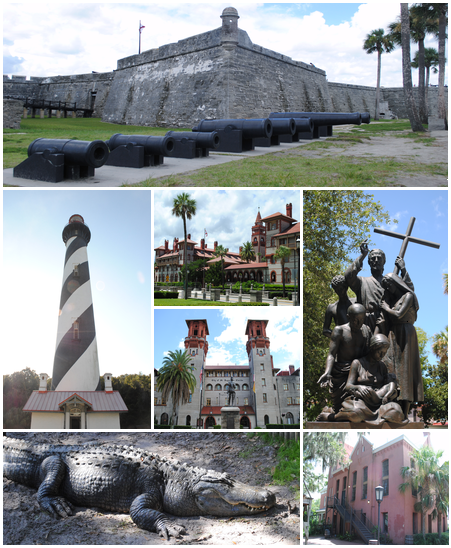
Founding of St. Augustine
St. Augustine is the oldest continuously inhabited European settlement in the continental U.S. Its foundation is steeped in history and was a key part of early European colonization efforts in the New World.
Pedro Menéndez led the establishment of St. Augustine de Avilés, a Spanish admiral and explorer. He landed on the Florida coast on August 28, 1565, the feast day of St. Augustine of Hippo, thus inspiring the name for the new settlement.
His expedition had two primary objectives: colonizing the region and eliminating any French incursion in the area.
Menéndez de Avilés acted in response to French encroachment.. The French had established a colony called Fort Caroline a year prior. Menéndez expelled the French from Fort Caroline, taking control of the area..
The Spanish established St. Augustine as a colony and a defensive military and political outpost to control the critical shipping route along Florida.. Its strategic location helped Spain control the important shipping route along the Florida Straits. The Spanish fortified the city to guard against pirate and colonial attacks.
The most well-known is the Castillo de San Marcos, a star fort made from coquina, a type of local shell stone. It’s the oldest masonry fort in the continental United States and is a testament to the long-lasting Spanish presence in the region.
In the centuries following its establishment, St. Augustine passed through several hands. It remained a Spanish territory for over 200 years until it was transferred to the British in 1763, following the Treaty of Paris. They returned it to Spanish control in 1783, before being ceded to the United States in 1821. Despite these changes in control, St. Augustine kept much of its unique historical and cultural heritage.
Today, St. Augustine is a popular tourist destination, offering a glimpse into the early colonial history of America. Its Spanish colonial architecture and fort offer a glimpse of the past.
Castillo de San Marcos
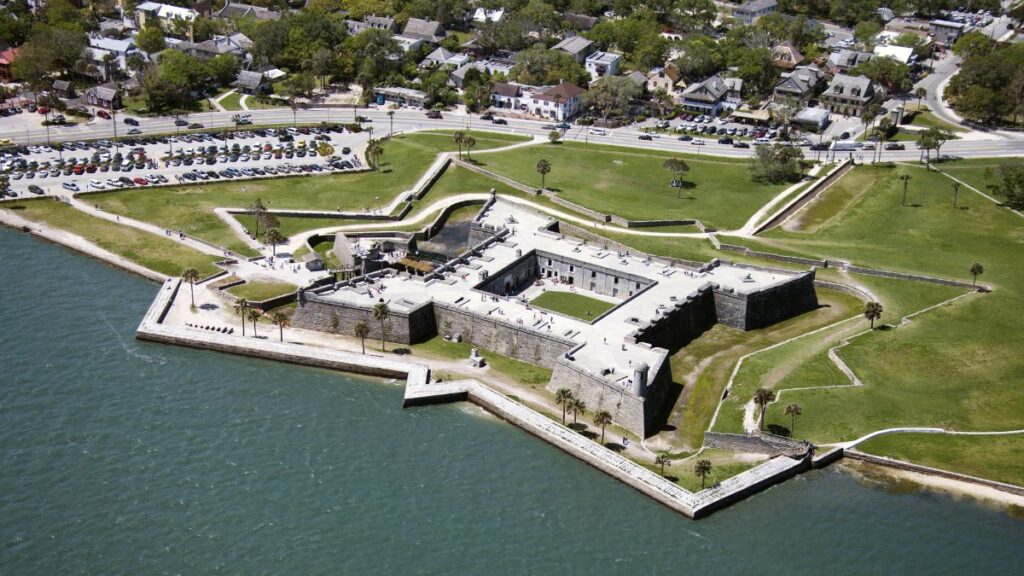
The Castillo de San Marcos is the most famous fort in St. Augustine, and its history dates back to the late 17th century. It is a symbol of the colonial era and stands as a testament to the strategic importance of St. Augustine during this period.
Built by the Spanish to protect the city of St. Augustine and the vital shipping route to the New World, the Castillo de San Marcos was completed in 1672 after more than twenty years of construction. The fort is made of coquina, a type of limestone consisting of shell and coral fragments, which is indigenous to the area. This material proved to be incredibly durable and resistant to enemy attack.
As the oldest masonry fort in the continental United States, the Castillo de San Marcos has weathered many conflicts and military events. It has stood against sieges and attacks from pirates and British forces and even saw use during the American Civil War. Today, the fort is a National Monument under the care of the National Park Service.
Visitors to the Castillo de San Marcos can delve into this rich history through various experiences. They can explore the many rooms within the fort, including the soldiers’ quarters, storerooms, and powder magazines. The fort’s gun deck provides a view of St. Augustine’s historic district and the Matanzas River, giving visitors a sense of the strategic advantage the fort’s location provides.
Ranger-led tours are a key attraction at the Castillo de San Marcos. The knowledgeable park rangers offer insight into the fort’s design, construction, historical significance, and the lives of those who lived and worked within its walls. These tours often include a walk around the fort’s outer defense works and an exploration of the interior casemates.
Another highlight for many visitors is the opportunity to witness cannon firings and historical reenactments. These events give a vivid picture of the fort’s active days, with staff dressed in period attire firing the cannons and demonstrating 17th-century military drills. At times, larger historical reenactments occur, where actors portray key events from the fort’s past.
The Castillo de San Marcos allows one to step back in time and experience a piece of American history. Its storied past and preserved structure make it an unmissable destination for those visiting St. Augustine.
Castillo de San Marcos Monument Contact Information:
Castillo de San Marcos National Monument
1 S Castillo Dr
St. Augustine, FL 32084
Phone: (904) 829-6506
Website: https://www.nps.gov/casa/index.htm
Fort Matanzas
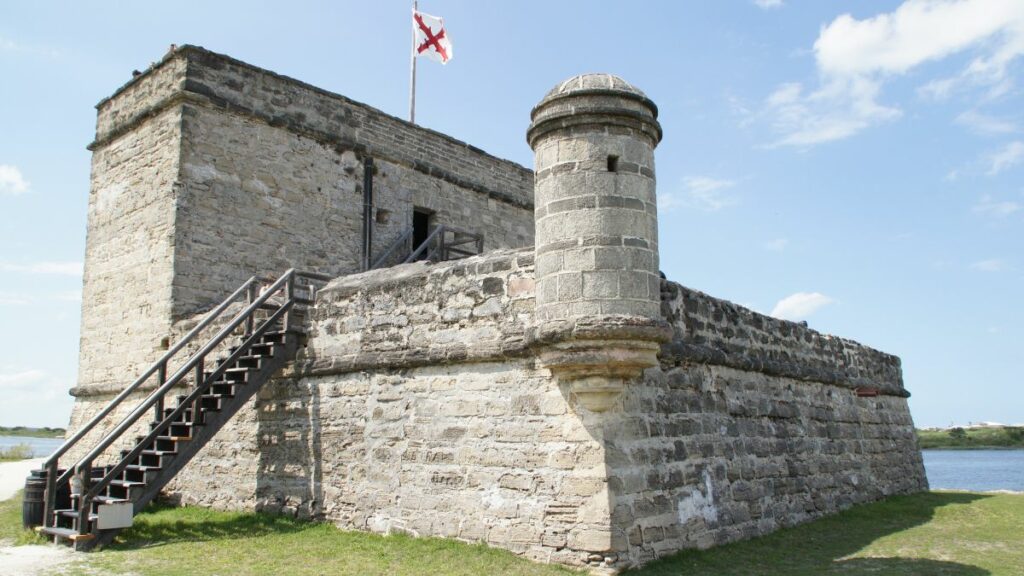
Fort Matanzas, located on Rattlesnake Island at the southern end of Anastasia Island, is an important historical monument that played a crucial role in defending St. Augustine. As part of the Fort Matanzas National Monument, it provides a rich historical experience complemented by natural beauty and recreational activities.
The construction of Fort Matanzas took place between 1740 and 1742 as a response to the British threat to Spanish Florida. The compact fort was strategically located to defend the southern approach to St. Augustine via the Matanzas River, a crucial waterway the Spanish used to access the city.
Its small size belied its importance; the fort was a crucial piece in the Spanish defensive system, helping to secure the city from potential British invasions.
Today, the Fort Matanzas Visitor Center is the gateway to exploring this historic fort. The Visitor Center houses educational exhibits detailing the fort’s history, the strategies employed in its defense, and its significance in the larger geopolitical context of the 18th century. Additionally, a small museum showcases various artifacts recovered from the site, offering a tangible connection to those who once lived and worked here.
Beyond the fort and visitor center, Fort Matanzas National Monument offers opportunities to enjoy the area’s natural beauty. Visitors can explore a nature trail that winds through the coastal maritime hammock and offers views of the Matanzas River. This trail allows one to see local wildlife and learn about the native flora. There’s also a picnic area where visitors can relax and soak in the tranquility of the surroundings.
One of the highlights of visiting Fort Matanzas is the National Park Service boat tour. This half-hour ferry ride departs from the visitor center and takes visitors across the Matanzas River to the fort. During the tour, visitors can enjoy beautiful views of the river and its marshes, and a Park Ranger provides historical context and fascinating stories about the fort and its role in the defense of St. Augustine.
Once at the fort, visitors can explore its gun deck, observe the living quarters, and even climb to the observation deck, which offers panoramic views of the surrounding area. This immersive historical experience provides a unique insight into the realities of 18th-century colonial life and military defense strategies.
Fort Matanzas National Monument Contact Information:
Fort Matanzas National Monument
8635 A1A S
St. Augustine, FL 32080
Phone: (904) 471-0116
Website: https://www.nps.gov/foma/index.htm
Fort Mose

Fort Mose, also known as Gracia Real de Santa Teresa de Mose, is a historic site of immense cultural and societal significance. Located just north of St. Augustine, Florida, Fort Mose is recognized as the first legally sanctioned free African settlement in what is now the United States.
The settlement was established in 1738 by the Spanish as a form of defense for St. Augustine, acting as a buffer between the Spanish city and British colonies to the north. However, Fort Mose was not just a military outpost but a beacon of hope for enslaved Africans seeking freedom from the British colonies.
Under the policy of the Spanish Crown, any enslaved person from British colonies who reached Spanish Florida was granted freedom, provided they converted to Catholicism and served in the Spanish militia. Hence, many runaway slaves from the British colonies sought refuge in Fort Mose, where they formed a unique, free community.
Today, Fort Mose Historic State Park is a testament to this remarkable chapter in American history. The park features a museum where visitors can learn about the fort and its inhabitants through educational exhibits and artifacts. The museum sheds light on the fort’s unique cultural, military, and historical aspects, including its role as a sanctuary for those escaping from the brutalities of slavery in the British colonies.
One of the highlights of the park is the Fort Mose Trail. This nature trail allows visitors to explore where the original fort once stood. As they walk the trail, visitors can imagine life in this unique community, surrounded by the area’s natural beauty.
The park also offers ranger-led tours, where knowledgeable park rangers guide visitors through the site, providing in-depth historical context and answering any questions. Special events, such as reenactments and celebrations, are also held throughout the year, further bringing the history of Fort Mose to life.
By offering these interactive experiences, Fort Mose Historic State Park is an educational platform for visitors to learn about this important site and its unique place in American history. The park provides an opportunity to reflect on the struggles for freedom and the cultural diversity that has shaped the nation.
Fort Mose and the other historic forts in St. Augustine played an essential role in shaping the city’s cultural heritage. Today, these forts serve as reminders of the past and as sites of education, recreation, and reflection, attracting tourists, history enthusiasts, and locals alike.
Fort Mose Historic State Park Contact Information:
Fort Mose Historic State Park
15 Fort Mose Trail St. Augustine, FL 32084
Phone: (904) 823-2232
Website: https://www.floridastateparks.org/parks-and-trails/fort-mose-historic-state-park
Related: Unveiling Historic Forts in Florida: An Epic Journey Through Time
Features and Construction
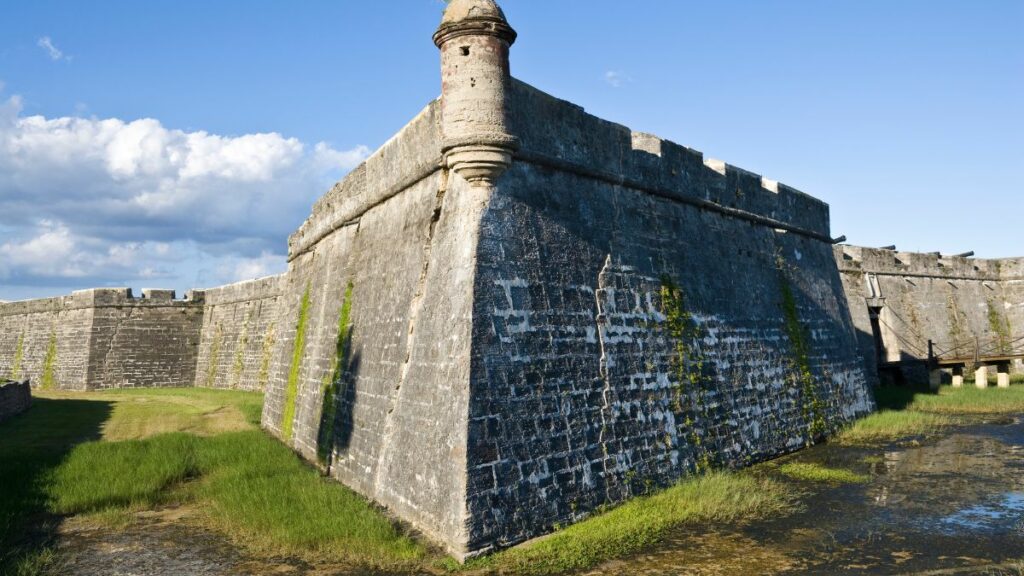
Coquina and Masonry Fortifications
The Castillo de San Marcos is the oldest masonry fort in the continental United States. One of the remarkable features of this fort is the use of coquina, a sedimentary limestone consisting mainly of shells, which is abundant in the area. Coquina’s porous nature allowed the fort to absorb cannon fire instead of shattering like traditional masonry.
The Spanish government built the fort to protect St. Augustine from enemies, including pirates and English forces.. Construction of the Castillo began in 1672 and continued for over 23 years, concluding in 1695.
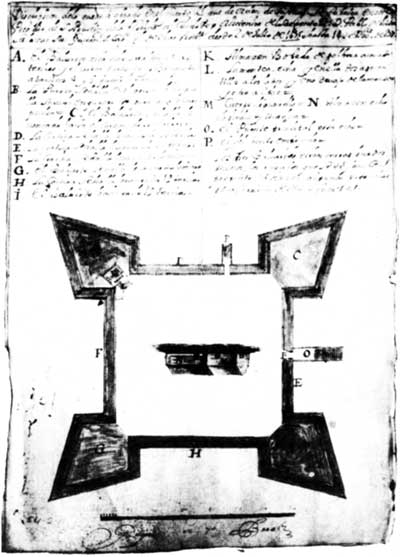
Cannons and Gun Decks
The cannon defenses of the fort had a crucial impact on its history. To deter enemy ships and protect the city, the Castillo de San Marcos had multiple gun decks with various cannons.. Rangers provide tours with demonstrations of weapons, including cannon firings.
At Fort Matanzas National Monument, another significant fort in St. Augustine, the single cannon on the gun deck was a strategic defense system. The fort protected St. Augustine during the War of Jenkins’ Ear.
The National Park Service now runs both forts, with visitor centers, nature trails, and picnic areas open to tourists. The Castillo de San Marcos and Fort Matanzas are tourist attractions showcasing St. Augustine’s history.
Related: Forts in Pensacola, Florida
Visiting the Forts
Admissions and Passes
It’s essential to be aware of admissions and passes when visiting St. Augustine’s historic forts.. The National Park Service manages both sites, offering various passes for entry. You can purchase passes online or at the respective visitor’s center.
| Fort | Admission Fee |
| Castillo de San Marcos | Adults $15, Children 15 and under free |
| Fort Matanzas National Monument | Free |
Visitor Centers
The Castillo de San Marcos and Fort Matanzas Visitor Centers are key destinations for tourists visiting St. Augustine, Florida. They serve as primary resources for understanding and appreciating the area’s rich history.
Castillo de San Marcos Visitor Center:
The Castillo de San Marcos Visitor Center is next to the historic fort. The Visitor Center has exhibits, artifacts, models, and displays about the fort..
Park Rangers, who are well-versed in the fort’s history and cultural importance, can provide guided tours, answer questions, and give detailed information about the site’s past. The Visitor Center also provides a park map to help visitors navigate the expansive fort and its surroundings.
The Visitor Center is equipped with restroom facilities for visitors’ convenience. A bookstore on the grounds sells souvenirs, including books on the fort’s history, postcards, and other mementos.
Fort Matanzas Visitor Center:
Fort Matanzas, like Castillo de San Marcos, played a crucial role in defending St. Augustine. Its visitor center provides an equally enriching experience. The Visitor Center contains exhibit areas where visitors can learn about the fort’s history and the broader regional context, including the relationships between the Spanish, the Native Americans, and other colonial powers.
Similar to the Castillo knowledgeable Park Rangers staff, de San Marcos Visitor Center, the Fort Matanzas Visitor. They provide guided tours about the fort’s history and architecture..
Restroom facilities are also available at this Visitor Center, ensuring the comfort of all visitors. Visitors can explore the bookstore and buy souvenirs like models of the fort, keychains, postcards, and more.
Tours and Reenactments
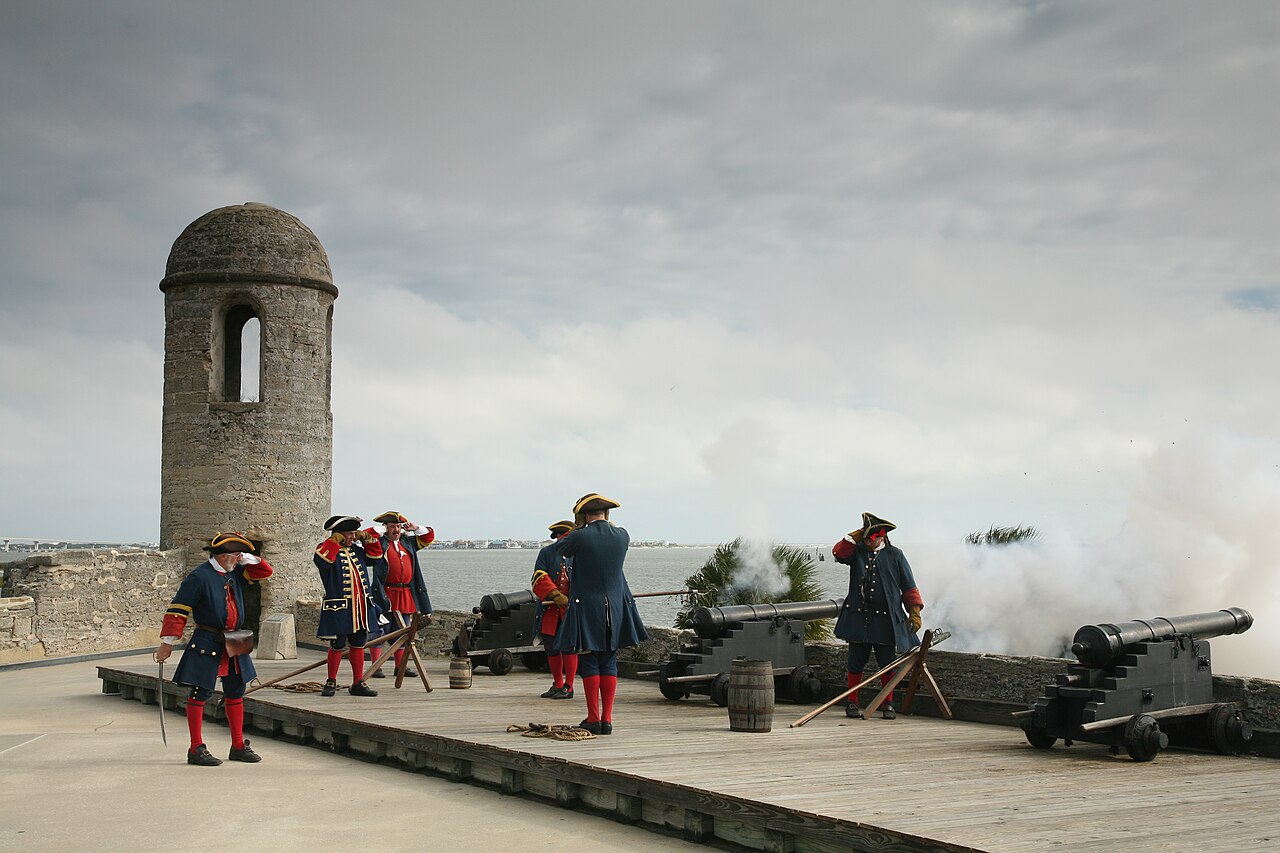
Visiting the forts of St. Augustine, such as the Castillo de San Marcos and the Fort Matanzas National Monument, provides an immersive experience of living history that offers visitors a unique opportunity to learn about the past engagingly.
At the Castillo de San Marcos:
Visitors can participate in ranger-led tours that deep dive into the fort’s history, architectural design, strategic role, and day-to-day operations during the Spanish colonial period. These tours are led by knowledgeable park rangers dressed in period clothing, which further adds to the authenticity of the experience.
A key highlight of a Castillo de San Marcos visit is the opportunity to witness cannon firings and weaponry demonstrations. Park staff, dressed as 18th-century Spanish soldiers, show visitors how cannons were loaded and fired, and they provide demonstrations of musket drills, giving visitors a glimpse into the realities of colonial-era military defense.
Moreover, the fort is occasionally the site of historical reenactments, where actors portray scenes from the fort’s vibrant past. These events bring to life the personalities, customs, and events that shaped the fort and the region.
The Castillo de San Marcos also offers a self-paced tour experience. This allowed visitors to explore the many rooms within the fort at their leisure, each of which served different functions, such as soldiers’ quarters, storage, and prison cells. The plaques and displays aid visitors in picturing life in the fort.
At the Fort Matanzas National Monument:
A visit to Fort Matanzas involves a unique journey that begins with a short, guided ferry ride to Rattlesnake Island, where the fort is located. This allows visitors to appreciate the fort’s strategic location and role in guarding the southern approach to St. Augustine.
Once on the island, visitors are greeted by park rangers who lead tours of the fort and provide engaging accounts of the site’s historical significance. Castillo de San Marcos and Fort Matanzas offer cannon firings and weaponry demonstrations..
Nature Trails and Maritime Forests in St. Augustine
Stunning natural landscapes that you can explore during your visit surround St. Augustine’s forts. The area around Fort Matanzas features a nature trail weaving through Maritime Forests on Anastasia Island, providing beautiful views of the Matanzas River and a picnic area.
The Fort Mose Trail is well-known for its connection to the first free African settlement in the continental United States, highlighting the region’s historical and cultural significance.
By experiencing these various activities, visitors will better understand St. Augustine’s rich history, including the Spanish and British forces that once controlled this part of Florida and the strategic importance of these forts for maintaining a presence in the New World.
Educational Resources
Field Trips and Curriculum
St. Augustine offers excellent educational resources for those interested in exploring the rich history of its forts, including the Castillo de San Marcos National Monument and Fort Matanzas National Monument.
The National Park Service provides educators with field trip opportunities and curriculum resources to facilitate experiential learning. Students can explore an old masonry fort and view ranger-led tours, cannon firings, and weaponry demonstrations.
School groups visiting the Castillo de San Marcos and Fort Matanzas can take advantage of ranger-led tours, which provide insights into the construction of these historic forts, the roles of Spanish soldiers, and their relationships with Native Americans.
Students can learn about the Fort Matanzas National Monument, its nature trail, barrier islands, and its role in protecting St. Augustine..
Distance Learning
Remote learners can explore St. Augustine’s forts through the many photographs, videos, and educational materials offered by the National Park Service and other organizations, such as the St. Augustine Historical Society. Distance learning resources offer students insight into Spanish soldiers’ history and daily life at forts.
Photographs and Videos
Captivating photographs and videos of St. Augustine’s historic forts provide a valuable resource for understanding the intricate design and function of the forts. The Castillo de San Marcos, with its large interior courtyard, various rooms, and gun deck, can be explored visually through high-quality photo content and video tours.
Similarly, images of Fort Matanzas allow viewers to virtually experience this historic site, including Rattlesnake Island, the Matanzas River, and the fort’s elevated location offering strategic views of the surrounding area.
Images and videos showcasing special events, such as cannon firings and reenactments by park rangers, further enrich the visual learning experience. Public domain photographs and videos are often available for educational use, allowing students and teachers to incorporate these valuable resources into their lessons and projects without copyright concerns.
Historical Events and Influences

Treaty of Paris and Revolutionary War
St. Augustine, home to the Castillo de San Marcos and Fort Matanzas National Monument, played a significant role in the Revolutionary War. Following the war’s conclusion, the Treaty of Paris in 1783 transferred control over the city from the British to the Spanish Empire. Great Britain had to relinquish its claim to Florida, and St. Augustine became a Spanish colony once more.
During the Revolutionary War, St. Augustine served as a haven for British loyalists, eventually prompting an attack by South Carolina and its American Indian allies. The city’s defense, which included the Castillo de San Marcos, successfully repelled the attack..
African and American Indian Settlements
Fort Mose, in St. Augustine, is the first free African settlement in the Continental United States. To weaken English colonies, the Spanish government offered asylum to runaway slaves. They encouraged African and American Indians to settle near the city, establishing Fort Mose and other settlements.
These settlements were crucial and intertwined with St. Augustine’s military history. Native Americans and Africans provided protection and support to Spain.
Attacks and Military History
The Castillo de San Marcos, the oldest masonry fort in the Continental United States, frequently protected St. Augustine and its residents throughout its history. Some significant incidents include:
- The fort’s strategic location and wooden forts protected St. Augustine from French attacks..
- A British fleet attacked the city in 1702, leading to a 50-day siege. The Spanish troops within the Castillo de San Marcos held their ground, forcing the British forces to retreat.
- As mentioned earlier, the Castillo was crucial in defending St. Augustine against enemy forces during the Revolutionary War.
Apart from these notable conflicts, the city’s forts continue to bear witness to centuries of military history. Today, visitors can explore these historic sites, attend weaponry demonstrations, and learn about St. Augustine’s rich past through guided tours and exhibits. Rattlesnake Island’s Fort Matanzas National Monument offers a look into the city’s military past.
Conclusion – Forts in St. Augustine, Florida
The forts in St. Augustine have played crucial roles in the colonial history of the United States, protecting the Spanish colonies of Florida against attacks from British forces in South Carolina and other English colonies.
Today, they serve as reminders of the rich history of St. Augustine and offer a fascinating glimpse into the past for those who explore their grounds.
Have you visited any of these forts mentioned in this article? If you have please leave a comment below and tell us about your experience.

Cory is a website owner and content creator who enjoys fishing, history, coin collecting, and sports, among other hobbies. He is a husband and father of four.
Romans 15:4 For whatever was written in former days was written for our instruction, that through endurance and through the encouragement of the Scriptures we might have hope.

